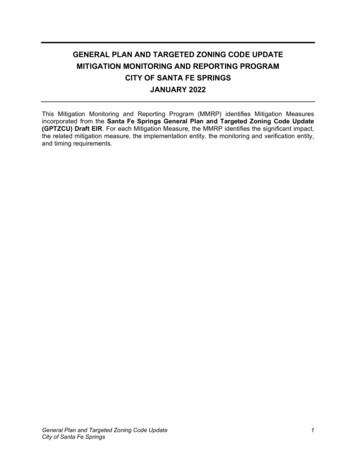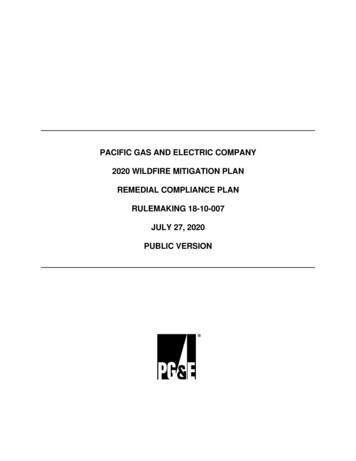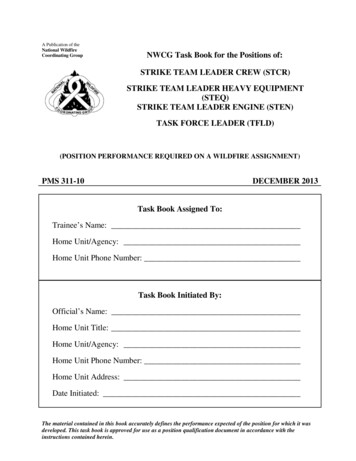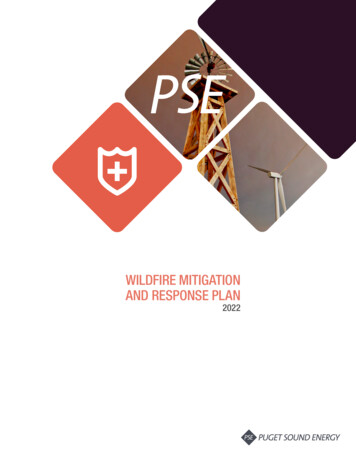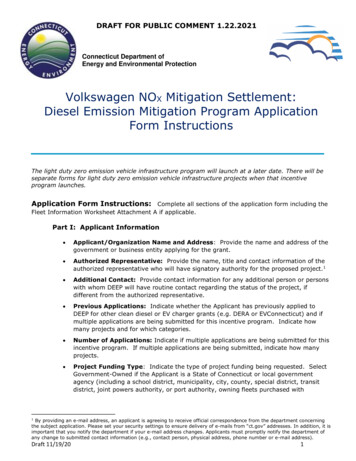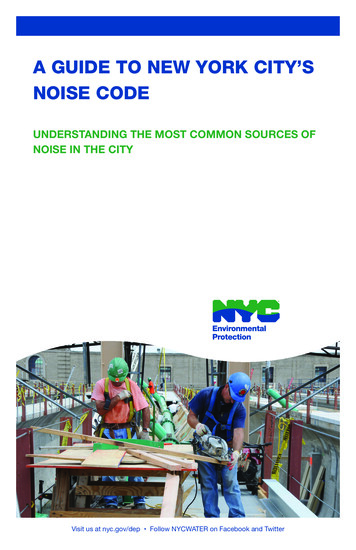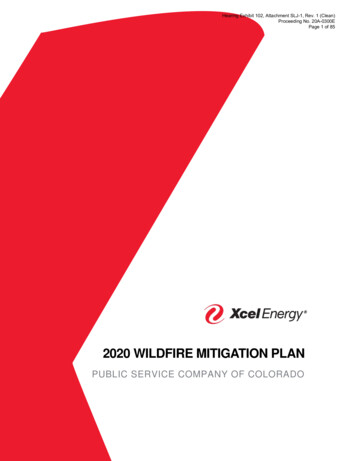
Transcription
Hearing Exhibit 102, Attachment SLJ-1, Rev. 1 (Clean)Proceeding No. 20A-0300EPage 1 of 85sideWord Document Title2020 WILDFIRE MITIGATION PLANPUBLIC SERVICE COMPANY OF COLORADO
Hearing Exhibit 102, Attachment SLJ-1, Rev. 1 (Clean)Proceeding No. 20A-0300EPage 2 of 85Table of Contents1.Executive Summary . 52.Introduction . 83.4.5.6.2.1.Public Service . 82.2.Policy Statement . 82.3.Asset Description . 82.4.Environmental Considerations . 9Overview of the Wildfire Mitigation Plan. 103.1.Risk Analysis. 123.2.Situational Awareness . 123.3.System Hardening. 133.4.Metrics Tracking and Operations . 133.5.Stakeholder Outreach. 133.6.Industry Engagement . 14Risk Analysis. 154.1.Wildfire Risk Model . 194.2.Simulation Results After WMP Implementation . 21Situational Awareness . 245.1.Meteorology . 245.2.Fire Spread Modeling . 245.3.Potential Tools . 24System Hardening Programs . 266.1.Inspection and Modeling . 286.1.1. Groundline Intrusive Pole Assessment Program . 286.1.2. Distribution Enhanced Above Groundline Inspection Program . 306.1.3. Transmission Visual Inspections . 326.1.4. Distribution Infrared Inspection Program . 336.1.5. Transmission Infrared Inspection Program . 346.1.6. Distribution Wind Strength Review Program . 346.1.7. Transmission Wind Strength Review Program . 366.1.8. Overhead Secondary Open Wire Quantification Program . 376.1.9. Distribution Overhead Safety Inspection . 382
Hearing Exhibit 102, Attachment SLJ-1, Rev. 1 (Clean)Proceeding No. 20A-0300EPage 3 of 856.1.10. Risk Modeling Program . 386.1.11. Situational Awareness Tools. 396.2.Repair and Replacement . 396.2.1. Distribution Pole Repair and Replacement Program . 406.2.2. Distribution Equipment Upgrade Program. 426.2.3. Transmission High Priority Defect Correction Program . 426.2.4. Major Transmission Line Rebuild Program. 446.2.5. Distribution Uninsulated Open Secondary Wire Replacement . 456.2.6. Distribution Small Conductor Replacement . 466.2.7. Covered Conductor Replacement . 466.3.System Protection . 486.3.1. Protection Study for Distribution Feeders. 486.3.2. Design and Construct Revised Protection Scheme Program . 496.3.3. Recloser Communications Network . 496.3.4. Substation Relay Upgrade for Remote Non-Reclosing Program . 506.3.5. Substation Relay Communication Upgrades Program . 516.3.6. Advanced Distribution Management System Enhanced System Protection . 516.4.Vegetation Management. 526.4.1. Mountain Hazard Tree Program . 546.4.2. Defensible Space Around Poles Program . 556.4.3. ROW Conversion Program (Transmission) . 586.4.4. Secondary Voltage Line Clearance Program (Distribution) . 586.5.Emerging Technologies . 596.5.1. Sensing and Detecting Distribution Arcing Fault Signature Library . 596.5.2. Monitoring Structural Health of Transmission Lines . 597.8.Stakeholder Outreach . 617.1.Community Outreach . 617.2.Town Hall Meetings . 627.3.Stakeholder Meetings . 637.4.Colorado Utility Summit . 647.5.Wildfire Mitigation Program Webpage and Other Resources. 64Operational Procedures . 658.1.Recloser Program . 658.2.Advanced Distribution Management System (ADMS) . 663
Hearing Exhibit 102, Attachment SLJ-1, Rev. 1 (Clean)Proceeding No. 20A-0300EPage 4 of 859.8.3.Red Flag Warning Protocols . 668.4.Public Safety Power Shutoffs (PSPS). 68Training . 699.1.Fire Prevention Training . 699.2.Downed Line and Ignition Reporting Training . 699.3.Electric Distribution Standards Training . 6910. Wildfire Emergency Response . 7010.1. Emergency Preparedness and Response . 7010.1.1. Enterprise Event Management Framework (EEMF) . 7010.1.2. Incident Response Plan (IRP) Program . 7010.1.3. Specific IRP Wildfire Annex. 7010.2. External Engagement. 7210.2.1. Community Relations Departments . 7210.2.2. Federal Government Engagement . 7310.2.3. Corporate Strategic Communications . 7310.2.4. Government Liaisons . 7311. Metrics, Tracking, and Reporting . 7511.1. Programs and Activities . 7511.2. Red Flag Warning Days . 7511.3. Downed Wires and Ignitions . 7611.4. Wildfires in the Company’s Service Territory . 7611.5. Investment. 7612. Conclusion . 77Appendix A. Glossary of Acronyms and Defined Terms.A-1Appendix B. Example of Red Flag Warning Map (Attachment to Red Flag Warning Email) . B-1Appendix C. Wildfire Interim Response Annex . C-1C.1High-Level Flowchart of the Wildfire Interim Response Annex .C-1C.2Example of Initial Notification Email .C-2Appendix D. Dashboard .D-14
Hearing Exhibit 102, Attachment SLJ-1, Rev. 1 (Clean)Proceeding No. 20A-0300EPage 5 of 851. Executive SummaryPublic Service Company of Colorado (“Public Service” or the “Company”) is committed to delivering electricityto our customers that is first and foremost safe, but also reliable and cost-effective. It is with this focus onsafety that the Company is implementing measures to reduce the risk of fire ignitions caused by the operationof our equipment, in order to minimize the potentially devasting impacts caused by wildfires.To be clear, the Company has always worked to reduce the risks presented by wildfires. However, recentincreases in the occurrence of severe weather events has impacted both the frequency and intensity ofwildfires in Colorado, along with much of the western United States. This, in turn, has changed the risk profilethat wildfires present to utilities and the communities we serve, which has driven increased focus on effortsand investments that can mitigate wildfire risk.Following the devastating California wildfires in 2017 and 2018, several of which were attributed to electricutility equipment, a number of utilities outside of California (including Public Service) have undertakenadditional efforts to evaluate how the risk of fires could impact their own customers, communities, and utilityoperations. In early 2018, the Company began engineering and risk analysis to determine overall wildfire riskand develop an initial plan to mitigate those risks. As part of this holistic evaluation, the Company determinedadditional actions could further promote public safety and systematically mitigate the risk of ignition fromelectrical infrastructure.In 2019, the Company formally assembled a Wildfire Mitigation Team to explore and implement the variousoptions Public Service could undertake to minimize the risks of its facilities being the source of ignitions thatcould cause wildfires. The Company’s updated, comprehensive 2020 Wildfire Mitigation Plan (“WMP” or“Plan”) is built around this emphasis on public safety, environmental stewardship, and stakeholderengagement, reflecting our commitment and desire to continually minimize all safety risks inherent in theoperation of an electric system. To these ends, the Company’s WMP provides for detailed inspections andremediations, vegetation management, infrastructure hardening, and operational protocols, as well as robustrisk analysis and stakeholder and community outreach processes.Public Service filed its first Plan with the Colorado Public Utilities Commission (“Commission”) in 2019 as partof its 2019 Phase I Electric Rate Case (“2019 Rate Case”). 1 An Unopposed Partial Settlement Agreement(“Wildfire Settlement Agreement”) was executed in November 2019 to resolve parties’ concerns related to the2019 WMP, which the Commission approved without modification by Decision No. C20-0096.1Commission Proceeding No. 19AL-0268E.5
Hearing Exhibit 102, Attachment SLJ-1, Rev. 1 (Clean)Proceeding No. 20A-0300EPage 6 of 85The Company completed the following WMP activities in 2019: Inspected 2,900 miles of transmission line via ground and aerial patrol (100 percent of circuits in theWildfire Risk Zone (“WRZ”); Inspected 2,900 miles of transmission line and equipment infrared; Analyzed four transmission circuits with 511 transmission structures for extreme wind loadingconditions; Corrected 72 transmission defects; Inspected 2,851 transmission wood poles intrusively; Inspected 67,162 distribution wood poles intrusively; Replaced 2,305 distribution wood poles due to groundline inspection failures; Upgraded multiple fuses and lightening arrestors; Completed system protection study that identified the need for 85 additional reclosers; Removed or mitigated hazard trees from an additional 20 circuits; Collected light detection and ranging (“LiDAR”) data via helicopter for 20 distribution segments andbegan wind loading analysis; Completed infrared inspections on 430 miles of distribution feeders; Completed focused program for enhanced above groundline (“AGL”) inspections on 792 distributionpoles; and Engaged with 14 counties and 3 community organizations as part of its community outreach effort.This updated Plan builds on the 2019 Plan and activities, providing more rigorous analysis and detail andincorporating data and lessons learned over the course of 2019. It is explicitly designed to continue theCompany’s proactive approach to keeping customers safe, mitigating the threat of electric facility ignitions byenhancing system reliability and resiliency, and addressing the concerns of stakeholders and parties to theWildfire Settlement Agreement, based on the core principles of Engagement, Acceleration, and Technology.We have completed, and will continue to complete, many inspections, studies, and modeling, and evaluatethose results to determine additional actions including replacements and additional inspection programs. The2020 Plan includes several new or enhanced initiatives since the 2019 Plan, including AGL inspections, coveredconductor replacement programs, and major line rebuild programs.In developing this Plan, the Company conducted extensive asset-based risk modeling to identify the highestrisk assets on its system. Using our own data and state data available through the Colorado Wildfire RiskAssessment Portal (“CO-WRAP”) developed by the Colorado State Forest Service, we have developed the WRZ,which is a targeted area where we will focus our efforts. This includes 2,100 miles of overhead distributionfeeder (out of 9,500 miles total on the system) and 2,900 miles of transmission lines (of nearly 5,000 total).While virtually all of our WMP efforts will occur within the WRZ, due to the nature of the system and ourgeography, there will inherently be some activities that occur outside the WRZ.6
Hearing Exhibit 102, Attachment SLJ-1, Rev. 1 (Clean)Proceeding No. 20A-0300EPage 7 of 85Public Service is committed to building on the meaningful progress we have made to date on wildfiremitigation, as well as the continual development, evolution, and improvement of our WMP over time. Alongthese lines, this Plan is not a static document and will inherently evolve as we complete studies andinspections, implement new technologies, and as best utility practices evolve in the coming years.7
Hearing Exhibit 102, Attachment SLJ-1, Rev. 1 (Clean)Proceeding No. 20A-0300EPage 8 of 852. Introduction2.1. Public ServicePublic Service is one of the four energy subsidiaries that make up Xcel Energy Inc. (“Xcel Energy”). As thelargest investor-owned utility in Colorado, the Company serves approximately 510,000 electric customers,400,000 gas customers, and 1.1 million electric and gas combined customers in its 8,200 square mile servicearea. Headquartered in Denver, Colorado, Public Service is engaged in the generation, transmission, sale, anddistribution of electricity for commercial and residential customers. The entire Public Service electrictransmission network is located within the State of Colorado and consists of over 4,983 miles of transmissionlines and 9,500 miles of overhead distribution lines. The Company’s electric system is summer-peaking, with a2019 peak customer demand of 6,881 MW.Xcel Energy is committed to protecting the environment as it transitions to cleaner sources of energy andcontinues to lead the clean energy transition in the U.S. as the first major U.S. power company aiming toprovide 100 percent carbon-free electricity by 2050, and by cutting greenhouse gas emissions. As part of ourcommitment to protecting our customers, local communities, and the environment, the Company is makingstrategic investments and improvements to bolster the performance of the power grid, build resilience, andenhance our ability to protect and respond to the threat of wildfires.2.2. Policy StatementPublic Service’s overarching goal is to provide safe, reliable, environmentally sustainable, and affordableelectric service to its Colorado communities. To meet this goal, we strive to construct, maintain, and operateour electrical lines and equipment in a manner that minimizes the wildfire risk associated with our system. Weare also continually evaluating new ways to mitigate this risk. While wildfires have long posed threats to utilitysystems, more recent events have served to re-focus the industry’s attention on wildfire mitigation practices.Because of this, the practices, techniques, and technologies used to minimize the risk of utility equipmentcaused wildfires are in a period of significant evolution and study, with Public Service committed to being alocal and industry-leader in this area.2.3. Asset DescriptionPublic Service provides electricity to its customers via generation, transmission, substation and distributionassets. Table 2-1 below depicts a high-level description of the Company’s transmission and distribution assets,and Table 2-2 provides an overview of Public Service’s assets located within the WRZ.8
Hearing Exhibit 102, Attachment SLJ-1, Rev. 1 (Clean)Proceeding No. 20A-0300EPage 9 of 85Table 2-1: Public Service AssetsAsset ClassificationAsset DescriptionTransmission line assetsAssets include conductors, transmission structures and switchesoperating at or above 69 kV (only 69 kV lines that are tied to generationare considered transmission).Distribution line assetsAssets include overhead conductors, underground cabling transformers,voltage regulators, capacitors, switches, line protective devices and streetlighting operating at less than 69 kV (all 69 kV lines not tied to generationare considered distribution).Substation assetsAssets include major equipment such as power transformers, voltageregulators, capacitors, reactors, protective devices, relays, open-airstructures, switchgear and control houses.Table 2-2: Wildfire Risk Zone AssetsAssetTotal Circuit-milesWRZ Circuit-milesTotal Transmission4,983% of Total OHMiles in WRZ2,90458%Total OHDistributionTotal OH Miles9,5482,19123%14,5315,09536%2.4. Environmental ConsiderationsPublic Service is committed to delivering affordable, reliable energy using advanced clean energy technologies.For the past 15 years, the Company has led the clean energy transition while ensuring reliability and enhancingaffordability. Now, Xcel Energy plans to increase renewable energy and reduce carbon emissions to levelsnever imagined a decade ago. The Company recognizes that climate change is an important issue for policymakers, investors, and customers. It is a priority for us as well, and the reason we have set ambitious goals toreduce carbon emissions 80 percent from 2005 levels by 2030 and deliver 100 percent carbon-free electricityby 2050.Public Service also recognizes how climate change has increased the risk, frequency, and severity of wildfires.Some studies indicate that climate change will continue to amplify the potential for wildfire activity. Also, thewildland-urban interface (“WUI”), which is the area where houses and wildland vegetation meet orintermingle, has continued to grow at a rapid pace, making it the fastest-growing land use type in theconterminous United States. WUI growth often results in more wildfire ignitions, putting more lives andhouses at risk. Since safety is a core value of the Company, our WMP is designed to help protect lives, homesand property from the threat of wildfire, while simultaneously mitigating the threat of wildfire to communities,ecosystems, and environment where we operate.9
Hearing Exhibit 102, Attachment SLJ-1, Rev. 1 (Clean)Proceeding No. 20A-0300EPage 10 of 853. Overview of the Wildfire Mitigation PlanThe primary objective of this WMP is to promote public safety through minimizing the risk of the Company’sequipment being a potential source for a wildfire ignition. In developing this Plan, the Company determinedthree main categories of additional actions could further promote public safety and systematically mitigate therisk of ignition from electrical infrastructure. Those categories include:Engagement - increased engagement with local, county, and state entities to facilitate morecoordinated planning and mitigation efforts across organizations and ensure our customers,communities, and emergency response responders are aware and informed of the Company’soperations, existing procedures, and WMP;Technology - equipment upgrades and increased use of technology, including extreme wind loadingconditions analyses and involving an increased collection of LiDAR data, to enable the Company tosystematically mitigate the risk of electrical infrastructure starting a wildfire, as well as the use ofUnmanned Aerial Systems to provide detailed pole top inspections;Acceleration - accelerating certain utility practices that mitigate wildfire risk, like routine poleinspections and replacements, for example, in areas designated as Public Service’s WRZ based on datafrom the Colorado State Forest Service, from traditional timeframes to shorter cycles presented aprudent measure to undertake to promote public safety and environmental stewardship in light ofincreasing intensity and frequency of wildfires in the state and expanding WUI exposure.While utilities have traditionally focused on reliability, the concept of resiliency has evolved from reliabilitywith the goal of minimizing and shortening power outages during all types of weather. Wildfire mitigationtakes this a step further, by focusing on proactive steps to minimize the risk of the system causing a problemthat could ignite a wildfire, while following the three guideposts identified above.This Plan describes the Company’s activities planned for 2020 to 2025 to minimize the risk of ignitions withinits service territory. The primary actions contained in this Plan include: Repair and Replacement Programs Inspection, Modeling, and Asset Data Gathering; Protection Programs; Expanded Vegetation Management; Metrics, Tracking, and Reporting; Ongoing Assessment of Other Activities for Future Consideration; and Community and Development.10
Hearing Exhibit 102, Attachment SLJ-1, Rev. 1 (Clean)Proceeding No. 20A-0300EPage 11 of 85These efforts are designed to reduce the frequency of potential ignition events and reduce the chance of anignition through updated protection practices. Table 3-1 below contains a summary of the programs andactivities we are implementing through this Plan.Table 3-1: Wildfire Mitigation Programs and ActivitiesInspection & ModelingGroundline Intrusive Pole AssessmentAbove Groundline InspectionAnnual Visual InspectionAnnual Visual InspectionInfrared InspectionInfrared InspectionOverhead Secondary Open Wire QuantificationStructure Wind Strength ReviewStructural Wind Strength ReviewRisk Modeling DevelopmentRepair & ReplacementPole Repair/ReplaceOpen Secondary Conductor ReplacementOverhead Covered ConductorEquipment upgrade (cutouts, arresters, etc.)High Priority Defect CorrectionMajor Line RebuildsOverhead RebuildsMinor Equipment ReplacementSmall Conductor ReplacementSystem ProtectionAdvanced Distribution Management EnhancedSystem ProtectionDesign/Construct Revised Protection SchemesProtection Study for FeedersRecloser Communications NetworkSubstation Relay Communications UpgradeSubstation Relay Upgrade for Remote NonReclosingEnhanced and Incremental VegetationManagementMountain Hazard Tree ProgramDefensible Space Around PolesSecondary Lines and Service Line ClearanceROW Vegetation Type ConversionMetrics and TrackingProgram and activity TargetsProgress and Outcome MetricsOperationsRFW Day ProceduresWork Practice ProceduresCommunity and Stakeholder OutreachCommunity Engagement MeetingsStakeholder Engagement ssionXXXXCurrent WMPXXXXXXXXCurrent WMPXX2021-2025XXXXCurrent ributionTransmissionCurrent WMP2021-2025XXXXXXXXCurrent WMPXXCurrent WMPXXCurrent ransmissionXXTransmissionXX11
Hearing Exhibit 102, Attachment SLJ-1, Rev. 1 (Clean)Proceeding No. 20A-0300EPage 12 of 853.1. Risk AnalysisRisk is often defined as the product of the likelihood of an event and the possible consequence or impact.Given that a significant wildfire event—especially a utility-caused wildfire—has a very low likelihood, theCompany’s Wildfire Risk Model, explained later in this document, focuses on the most significant potentialimpacts (the “tail” events in the distribution of outcomes in the model’s simulation). In that sense, the term“risk” is often used to refer to the possible consequence of a wildfire event (regardless of likelihood). Forexample: CO-WRAP uses the term “risk” to describe the potential wildfire consequence due to variousattributes, such as availability of fuels and proximity to the WUI. One of the Company’s first efforts inpreparing the 2019 WMP was working to objectively understand the wildfire risk within its service territory.The Company consulted with a fire scientist and engaged a utility wildfire consultant to assist it in developingand launching its Wildfire Mitigation Program. The Wildfire Mitigation Team ultimately chose the CO-WRAP,which is administered by the Colorado State Forest Service, to help determine which areas to focus on andidentify the overhead asset locations that are in a WRZ. This work provided a score for each overhead assetlocation in Colorado. Each asset was ranked from 1 to 5, with 1 being the lowest and 5 being the highestwildfire potential consequence. Locations that received a score of 3, 4, or 5 are considered in the WRZ, alongwith any asset location that is within 1,000 feet of an asset location with a score of 3, 4, or 5.3.2. Situational AwarenessSituational awareness refers to the ability to monitor environmental conditions to make critical operationaldecisions more quickly and effectively. Utili
Xcel Energy is committed to protecting the environment as it transitions to cleaner sources of energy and . Colorado. Protection Recloser Communications Network . 2020 2020-- - - - -Hearing Exhibit 102, Attachment SLJ-1, Rev. 1 (Clean) Proceeding No. 20A-0300E . Wildfire .
